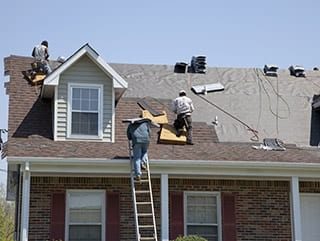Replacing your roof is a big deal, but don’t sweat it! Whether you’re dealing with storm damage or your roof has seen better days, we’re here with all the must-knows before you start. Embarking on this significant home improvement project just got a lot easier!
Understanding the Need for Replacing Your Roof
Understanding when it’s time for replacing your roof is crucial. Various signs can indicate a need for action. You may have noticed missing shingles after a storm or a series of leaks that won’t quit. Age is another factor; it might be time for a fresh start if your roof is 20 years or older. Remember to consider these signs. Acting swiftly can prevent more significant problems in the future, like structural damage to your home.
Remember, replacing your roof isn’t just about aesthetics; it’s vital to maintaining a safe and healthy living environment. So, keep an eye on your roof’s condition and act when the time is right. It’s one of the best ways to protect your home and peace of mind.
Choosing the Right Materials When Replacing Your Roof
Selecting the ideal materials is an integral step when replacing your roof. The right choice will enhance your home’s appearance, withstand local weather conditions, and suit your budget. Here’s a rundown of popular options:
- Asphalt Shingles: An economical choice, they are versatile and easy to install. They come in various colors to match your home’s style. They do, however, have a shorter lifespan than other materials.
- Metal Roofing: Durable and fire-resistant, metal roofs can be more expensive. They perform well under extreme weather conditions and have a longer lifespan.
- Clay Tiles: Ideal for warmer climates, clay tiles are resistant to rot and fire. While they offer longevity and unique aesthetics, they can be heavy and require additional structural support.
- Wood Shakes: Wood shakes lend a natural and timeless appeal but require regular maintenance to prevent rot and insects.
Each roofing material has distinct advantages and disadvantages, so consider your needs and consult an expert before deciding. Remember, replacing your roof is a long-term investment in your home’s future.
The Process of Replacing Your Roof
The process of replacing your roof may seem daunting, but fear not! Here’s a breakdown of what typically happens during a roof replacement:
- Preparation: The roofing team will take necessary precautions to protect your property, such as laying tarps to catch debris and safeguarding landscaping.
- Old Shingle Removal: The existing shingles are carefully removed, ensuring the underlying structure is accessible for inspection.
- Structural Inspection: The roofing professionals examine the underlying structure for any signs of damage, rot, or weak spots. If issues are discovered, repairs may be needed before proceeding.
- Installation of New Roof: The new roof installation begins once the structure is deemed sound. This includes adding a waterproof underlayment, applying new shingles or other chosen roofing material, and securing it properly.
- Radiant Barrier Consideration: Discuss with your roofing professional the option of incorporating a radiant barrier during installation. This reflective insulation can enhance energy efficiency by reducing heat transfer.
- Final Cleanup: The roofing team ensures that all debris, old materials, and nails are removed from your property, leaving it clean and safe.
Remember, a reputable roofing contractor will guide you through each step and provide updates.
The Cost of Replacing Your Roof
Regarding the cost of replacing your roof, several factors come into play. Understanding these factors can help you budget effectively and avoid any surprises along the way. Here’s what you need to know:
- Materials: Different roofing materials come with varying price tags. Asphalt shingles are generally more affordable, while metal or slate can be more expensive but offer longevity.
- Roof Size: The cost is strongly related to the size of your roof. A larger roof needs more materials and labor, raising the entire price.
- Roof Design Complexity: Intricate roof designs with multiple angles, curves, or dormers can increase the complexity of the installation, leading to higher costs.
- Structural Repairs: During the roof replacement, underlying structural issues may be uncovered, such as rot or damage. Addressing these repairs adds to the overall cost.
- Hail Damage or Other Issues: If your roof has experienced hail damage or other issues that need repairs, these additional fixes will impact the final cost.
Remember to obtain detailed quotes from reputable all service roofing contractors, that include all potential costs. This way, you can make an informed decision and ensure that you clearly understand the investment required for replacing your roof.
 Selecting a Reliable Roofing Contractor for Replacing Your Roof
Selecting a Reliable Roofing Contractor for Replacing Your Roof
When replacing your roof, choosing a reliable roofing contractor is paramount. Follow these tips to make the right choice:
- Look for an “all service roofing” provider with a wide range of expertise.
- Check their experience in roof repairs, roof replacement, and even historic restoration.
- Read online reviews and testimonials to measure their reputation and customer satisfaction.
- Feel free to ask for references from past clients.
- Check to see if the contractor is licensed, insured, and offers warranties.
By choosing a trustworthy and experienced roofing contractor, you can have peace of mind knowing that your roof replacement project is in capable hands.
Preventive Maintenance to Extend the Life of Your Roof
Proactive maintenance is essential for extending the life of your recently installed roof. Here are some preventive measures to consider:
- Conduct semi-annual roof inspections to catch any potential issues early on.
- Promptly address minor issues such as missing or loose shingles to prevent further damage.
- Keep your gutters clean and debris-free to ensure proper drainage and avoid water buildup.
- Trim overhanging tree branches to minimize the risk of damage from falling limbs.
- Consider applying a protective coating or sealant to enhance the durability of your roof.
Implementing these simple preventive measures can extend the life of your roof and reduce the need for future repairs or replacements.
Takeaway
Replacing your roof is an essential investment in the safety and value of your property. By understanding the process, you’re one step closer to enjoying the peace of mind a sturdy, new roof offers.
Ready to take the next step in replacing your roof? The team at Summit Roof Service Inc. is here to help. Visit our social media for more details. Contact us at Allen (972) 715-1655 | Grapevine (972) 484-7774 to discuss your roof replacement needs today!
